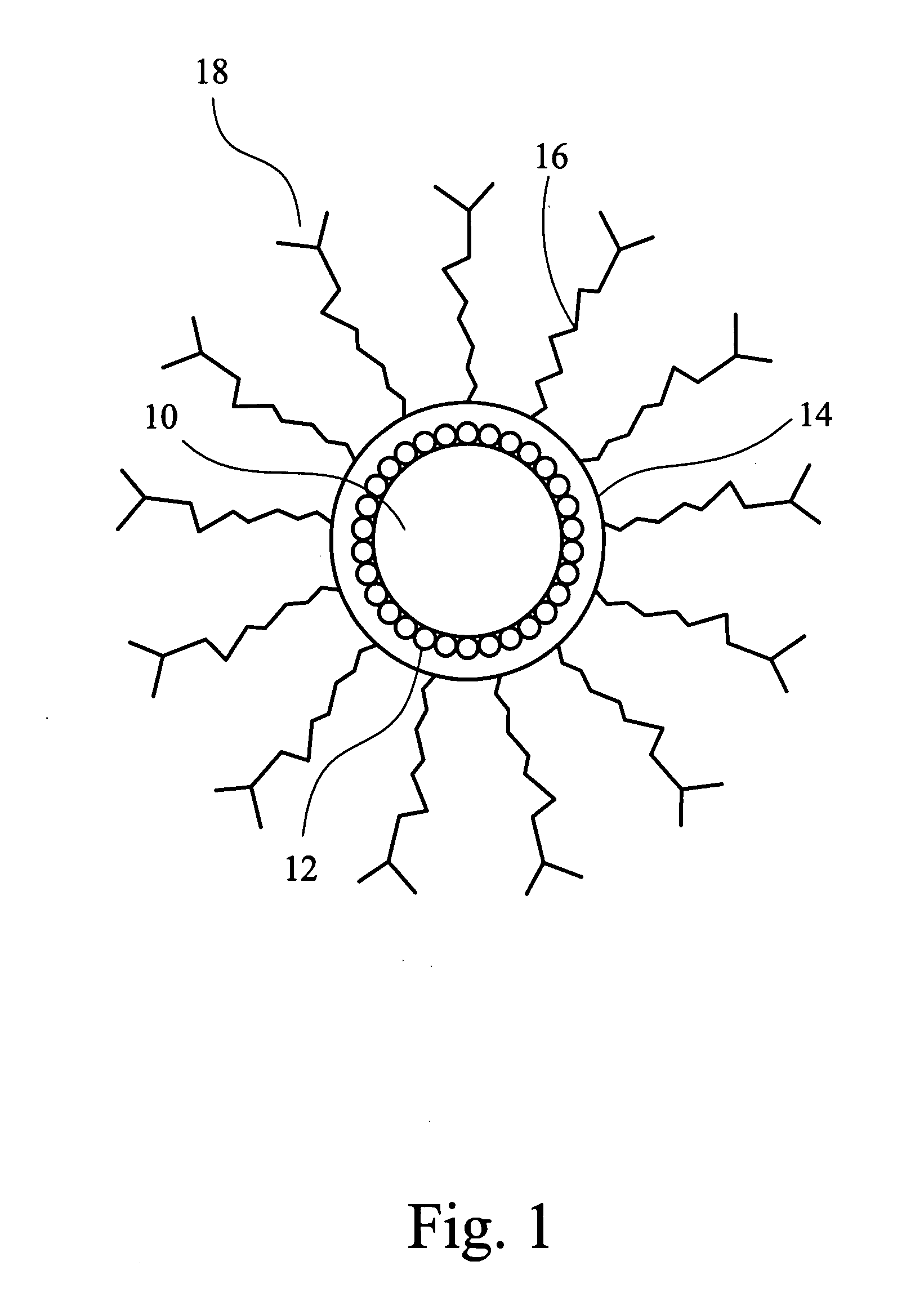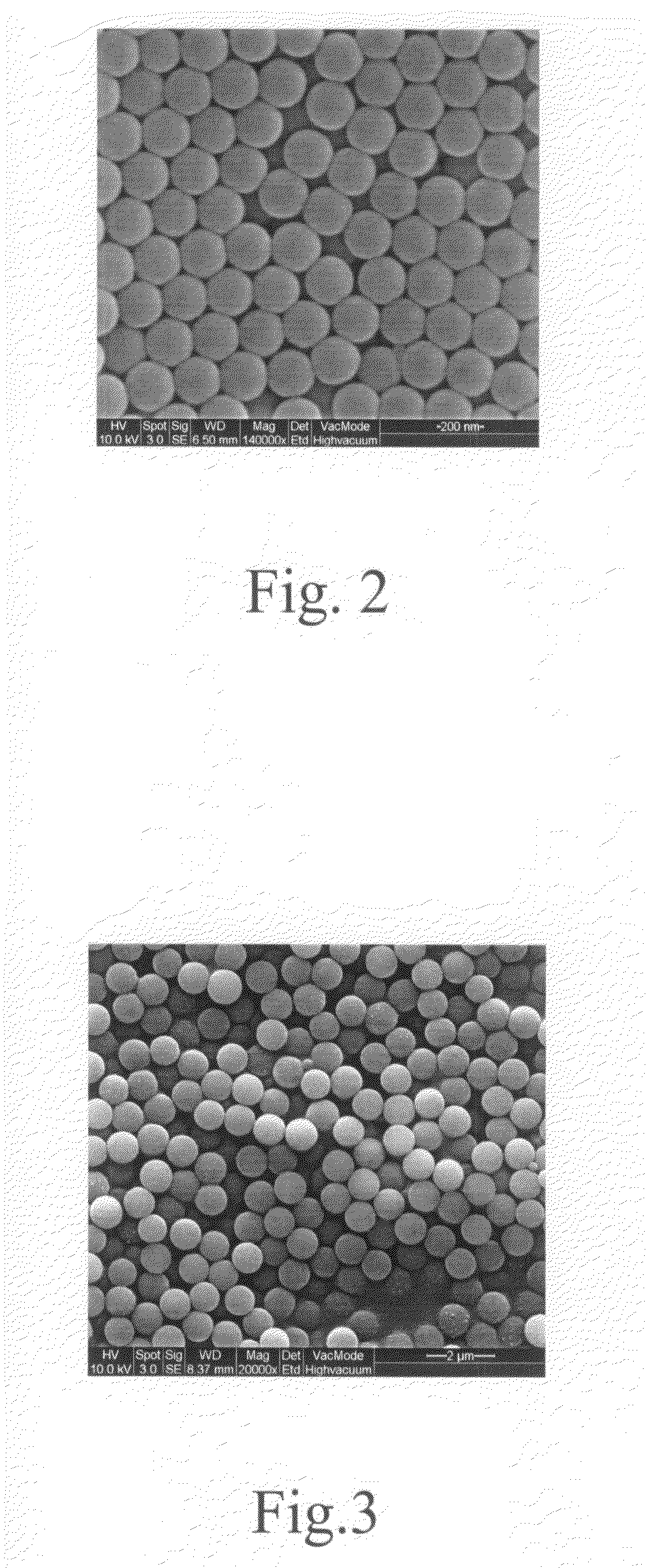Magnetic particles and fabrication method thereof
a technology of magnetic particles and fabrication methods, applied in the field of magnetic particles, can solve the problems of insufficient control of magnetic particle properties and special challenges of nucleic acids in isolation from natural environments, and achieve the effects of improving storage stability, uniform diameter distribution, and high magnetization
- Summary
- Abstract
- Description
- Claims
- Application Information
AI Technical Summary
Benefits of technology
Problems solved by technology
Method used
Image
Examples
example 1
Polymer Core Preparation
[0030]18 ml of styrene, 1 ml of methylacrylic acid, 0.1 g of K2S2O8, 10 ml of ethanol, and 60 ml of deionized water were placed in a reaction vase. Under nitrogen, the mixture was stirred at 70° C. for reaction for 24 hours, and then cooled to room temperature to obtain polystyrene cores. The polymer cores were observed by SEM to measure the diameter thereof. The SEM photograph of the polymer cores according to the above reaction condition is shown in FIG. 3. As shown, the diameter of the polymer core is about 921.6±75.3 nm, and diameter distribution is uniform.
[0031]The reaction condition can be adjusted such that a ratio of water to ethanol is 7:0 and the mixture was stirred at 80° C. for reaction for 24 hours with other conditions remaining, resulting in the diameter of the obtained polymer core was about 220.4±6.5 nm. SEM photograph of the polymer cores according to the second reaction condition is shown in FIG. 2. The diameter distribution of the second ...
example 2
Covering the Polymer Core with Magnetic Material Layer
[0032]200 mg of polystyrene core of Example 1 and 30 ml ethylene glycol were agitated for 10 minutes by ultrasonic wave and 120 ml of deionized water was added. Subsequently, 2 g of hexamethylenetetramine, 0.1 g of KNO3, and 1 g of FeCl2 were added to the mixture at 80° C. for reaction for 4 hours. After the reaction completed, the product was washed by deionized water to obtain a magnetic material layer of Fe3O4 covering the polystyrene core. FIG. 4 is a SEM photograph of covering the polymer cores of diameter of 220.4±6.5 nm with magnetic material layer. The overall diameter of the particles in FIG. 4 was about 250.4±7.2 nm and saturation magnetization was 61.3 emu / g. FIG. 5 is SEM photograph of covering the polymer cores of diameter of 921.6±75.3 nm with magnetic material layer, with overall diameter of about 950±77.2 nm and saturation magnetization of 52.3 emu / g. The thickness of the magnetic material layer was about 30 nm.
example 3
Covering the Magnetic Material Layer with Silicon Containing Layer
[0033]50 mg of Example 2, 50 ml of deionized water, and 1.25 g of polyvinylpyrrolidone (PVP-10) were placed in a reaction vase, and stirred at 600 rpm for 24 hours for reaction. The solid product was separated by centrifuge, and 50 ml of ethanol was added to the solid product into a mixture. Subsequently, 2.42 ml solution of 4.2% ammonia water in ethanol, and a solution of 10% tetraethyl orthosilicate (TEOS) in ethanol were added and stirred for reaction for 15 hours to obtain a silicon containing layer covering the magnetic material layer into the magnetic particles of invention. FIGS. 6 and 7 are TEM photographs of covering the magnetic material layer with the silicon containing layer. FIG. 8 is EDX ultimate analysis spectrogram of Example 3. As shown in FIG. 8, there were at least three peaks of Si, O and Fe of the magnetic particles, indicating formation of the silicon containing layer thereon.
PUM
| Property | Measurement | Unit |
|---|---|---|
| Thickness | aaaaa | aaaaa |
| Thickness | aaaaa | aaaaa |
| Diameter | aaaaa | aaaaa |
Abstract
Description
Claims
Application Information
 Login to View More
Login to View More - R&D
- Intellectual Property
- Life Sciences
- Materials
- Tech Scout
- Unparalleled Data Quality
- Higher Quality Content
- 60% Fewer Hallucinations
Browse by: Latest US Patents, China's latest patents, Technical Efficacy Thesaurus, Application Domain, Technology Topic, Popular Technical Reports.
© 2025 PatSnap. All rights reserved.Legal|Privacy policy|Modern Slavery Act Transparency Statement|Sitemap|About US| Contact US: help@patsnap.com



